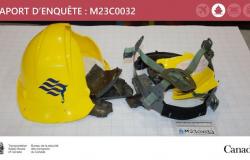
The probe Hera took off Monday to study the asteroid Dimorphos, struck two years ago by a NASA spacecraft to deviate its trajectory during an unprecedented “planetary defense” test.
Nestled in the fairing of a SpaceX Falcon 9 launcher, the ESA probe took off from Cape Canaveral, Florida, at 10:52 a.m. local time (10:52 GMT).
The launch was preceded by several days of uncertainty. SpaceX, whose Falcon 9 had encountered an anomaly on its previous flight, only obtained the green light from the American authorities on Sunday.
And the weather conditions were uncertain as the hurricane approached Milton on the coast of Florida.
Miltonwhich strengthened into a Category 5 hurricane on Monday, has already led to the postponement of the launch, initially scheduled for next Thursday, of a NASA mission, Europa Clipper, which is to study an icy Moon of Jupiter, Europa, to find out if its underground ocean can support life.
Hera’s journey will be less distant. Its target is located 11 million kilometers away in the asteroid belt between Mars and Jupiter.
The probe must meet Dimorphos, a small body only 160 meters in diameter, which is the Moon of a larger asteroid, Didymos.
Two years ago, in a scenario worthy of a science fiction novel, a NASA spacecraft deliberately crashed into its surface.
The objective of this unique “planetary defense” test was to evaluate whether it was possible to deviate its trajectory and use this technique if, in the future, an asteroid threatened to hit the Earth.
One of the least probable natural risks, but which has already caused cataclysms in the past and is likely to recur in the long term.
It is estimated that an object of one kilometer (triggering a global catastrophe such as the extinction of the dinosaurs) crashes into the Earth every 500,000 years, and an asteroid of 140 m (the threshold of a regional catastrophe ) every 20,000 years.
Nanosatellites
During the DART (Double Asteroid Redirection Test) mission, the NASA device, the size of a large refrigerator, managed to move Dimorphos by reducing its orbit by 33 minutes.
But we don’t know what effects the impact had on the small asteroid, or even what its internal structure was before it.
This is Hera’s mission. Costing 363 million euros (542 billion Canadian dollars) and equipped with 12 instruments, the probe will carry with it two nanosatellites, The youth et Milaniwhich will try to land on its surface.
The first is equipped with a low-frequency radar and a gravimeter to probe the structure of the asteroid and measure its gravity field.
The second will study the composition of Dimorphos using a multispectral camera and a dust detector.
Numerical simulations suggest that Dimorphos is an agglomerate of rocks linked together by gravity, a body with very little resistance in which “we sink like in sand without cohesion”, explained during a briefing. press ahead of the launch Patrick Michel, scientific manager of the Hera mission at ESA.
“The consequence is that instead of making a crater,” DART would have “completely deformed” Dimorphos, he added.
But there are “other possibilities”, scientists still having difficulty understanding these bodies with very low gravity, “whose behavior defies intuition”, according to Mr. Michel.
After a flyby of Mars next year, Hera will arrive near Dimorphos in December 2026, for an initial duration of six months.





